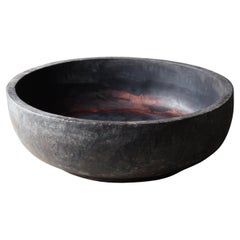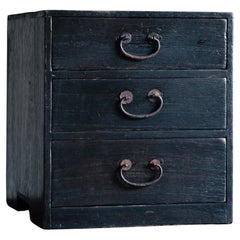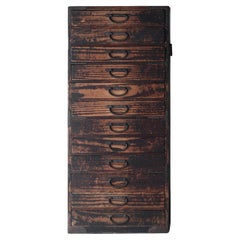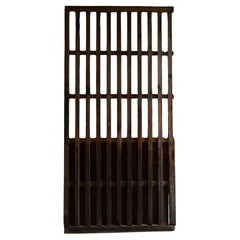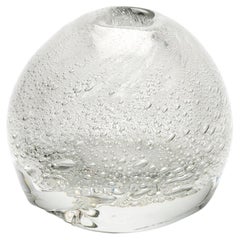Japan - Furniture
to
549
508,632
446,202
1,990
1,325
26
187
137
110
11
8
4
3
3
2
2
1
1
139
382
1,469
1,351
459
520
271
7
8
13
23
26
107
112
84
76
23
1,118
831
784
765
764
2,745
1,929
1,891
707
706
3,341
3,248
3,282
289
58
41
34
33
Item Ships From: Japan
Japanese Antique Huge Wooden Bowl 1906s / Primitive Object Wabisabi Mingei
Located in Chōsei District Nagara, JP
This is a huge old Japanese lacquer wood bowl.
It was manufactured in 1906 (Meiji period), and its age can be read from the writing on the bottom. The material used is cedar wood, ma...
Category
Early 1900s Japanese Meiji Antique Japan - Furniture
Materials
Cedar, Lacquer
Japanese vintage urushi small Kiri tansu box chest of drawers, wabi sabi mingei
Located in 常陸大宮市, JP
Japanese vintage small box tansu chest of drawers, Kohikidashi, fully made of Kiri (Paulownia).
Refinished by seller with traditional black Urushi ...
Category
20th Century Japanese Folk Art Japan - Furniture
Materials
Wood
Japanese Antique Drawer / Tansu Storage / Meiji Period Wabi-Sabi
Located in Iwate-gun Shizukuishi-cho, Iwate Prefecture
This is an old Japanese drawer.
It seems to be around the Meiji period (1868-1912s).
It is made of cedar, and the front of the drawer peels off the paint due to friction due to agi...
Category
Late 19th Century Japanese Meiji Antique Japan - Furniture
Materials
Iron
$1,040 Sale Price
48% Off
19th thick lattice door, antique sliding door w/ panel. Japanese wabi sabi shoji
Located in 常陸大宮市, JP
Japanese antique thick lattice sliding door, ara-koshido,
Edo to Meiji period circa 1870s to early 1900s.
Nowadays it's getting harder & more rare to find a sliding door with thick...
Category
Late 19th Century Japanese Edo Antique Japan - Furniture
Materials
Wood
$682 Sale Price
25% Off
Japanese Antique Earthenware Tea Bowl/Edo Period/1700-1800/'Hagi Ware'
Located in Sammu-shi, Chiba
This is Hagi ware made in the middle of the Edo period.
Hagi ware is a type of pottery that began in Hagi City, Yamaguchi Prefecture in the early Edo period...
Category
18th Century Japanese Edo Antique Japan - Furniture
Materials
Pottery
Tapio Wirkkala / ART OBJECT 3235 / Iittala
By Tapio Wirkkala, Iittala
Located in Shibuya-Ku, JP
Manufactured between 1947 and 1949.
One of Tapio Wirkkala's earliest designs for IITTALA. This crystal-glass piece was made using the free-blown technique, which creates bubbles insi...
Category
1940s Finnish Scandinavian Modern Vintage Japan - Furniture
Materials
Art Glass, Blown Glass
Japanese Vintage Writing Table, Showa Period black lacquer, Solid Wood
Located in Hitachiomiya-shi, 08
This vintage desk was crafted in the Early Showa Period '1926-'.
Crafted entirely from solid kihada (Japanese Amur cork tree) wood.
Featuring a sleek black finish and a minimalist ...
Category
Mid-20th Century Japanese Showa Japan - Furniture
Materials
Wood
Japan Antique Stone Tea Garden Lantern, Stunning Design
Located in South Burlington, VT
A tall 88 Inch antique classic tea motif lantern with all original pieces.
Please view the video.
The Zendō-ji Gata lantern Ishidōrō (禅導寺型石灯籠) is a unique design and very special ...
Category
19th Century Japanese Meiji Antique Japan - Furniture
Materials
Granite
17th Century Japanese Screen Pair. Tiger & Dragon by Kaiho Yusetsu
Located in Kyoto, JP
Kaiho Yusetsu (1598-1677)
Tiger and Dragon
Early Edo Period, Circa 1650
A Pair of Six-fold Japanese Screens. Ink and slight color on paper.
Dimensions:
Each screen: H. 171 cm x W. 380 cm (67.5’’ x 149.5’’)
In this pair of early Edo period Japanese screens a group of tigers prowl in a bamboo grove whipped with fierce wind, while a dragon claws through clouds and mist. The dragon embodies elemental qualities - looming out of the mist, the coils of its body disappearing in the clouds. The dragon is calling for rain, symbolizing spring which is considered the fountain of life. On the other side, the tigers calls for the wind, symbolizing autumn which is considered the end of life. Tigers were familiar motifs within Japanese art from ancient times though the animals were imaginary to the people in the 17th century. While dragons and tigers are usually associated as sacred and ferocious, in this painting, both animals have rather amusing expressions. The tigers appear to glare at the dragon with cat-like eyes, and the look on the swirling dragon’s face appears almost affectionate - lending a playful flair to an otherwise magnificent theme.
The tiger and dragon are cosmological symbols of the balancing forces in the world. Screens such as this were originally meant to express the fluctuating nature of the world. For Japanese in the early Edo period, they likely suggested the powers of the cosmos. In Japan the tiger and dragon motif was originally absorbed into the circles of Zen monasteries before spreading into the secular world. The theme especially appealed to the military classes with the Kano school, the official painters to the Shogun and the samurai, being the leading contributors. The painter of this pair of screens, Kaiho Yusetsu (1598-1677), was closely patronized by the third Shogun Tokugawa Iemitsu. In his later years he worked with Kano school artists...
Category
Mid-17th Century Japanese Edo Antique Japan - Furniture
Materials
Silk, Wood, Paper
Hanger Rack by Isamu Kenmochi, Japan
By Isamu Kenmochi
Located in Tokyo, Tokyo
Beautiful vintage wood hat and coat stand designed by Isamu Kenmochi, one of Japan’s leading modernist designers. This piece exemplifies his signature approach to blending modernist ...
Category
Late 20th Century Japanese Japan - Furniture
Materials
Steel
Alien Chair Carlo Forcolini 1980s Design
By Alias, Carlo Forcolini
Located in Shibuya-ku, Tokyo
Alien chair design by Carlo Forcolini in the 1980s.
Yellow wood seat and back. Frame is painted steel. Manufactured by Alias Italy.
Category
1980s Italian Post-Modern Vintage Japan - Furniture
Materials
Steel
$2,240 Sale Price
20% Off
Japanese Antique Drawer Natural Color 1860s-1900s / Storage Tansu Wabisabi
Located in Sammu-shi, Chiba
Very old Japanese small drawer storage.
The furniture is from the Meiji period (1860s-1900s).
It is made of cedar wood.
The handles are made of iron.
The reinforcing brackets are mad...
Category
Early 20th Century Japanese Meiji Japan - Furniture
Materials
Cedar
Japanese antique bamboo woven basket/wall hanging vase/1868-1920/Mingei
Located in Sammu-shi, Chiba
This is a woven bamboo basket made in Japan from the Meiji to Taisho periods (1868-1920).
I don't know if the baskets actually used by farmers were repurposed as flower vases, or if ...
Category
Early 20th Century Japanese Meiji Japan - Furniture
Materials
Bamboo
Old Indian wooden low chairA/20th century/Chair made from a single piece of wood
Located in Sammu-shi, Chiba
This is an old wooden chair made in India, dating back to around the 20th century. Carved directly from a single log, it conveys a warmth and strength that can only come from handcra...
Category
20th Century Indian Other Japan - Furniture
Materials
Wood
Japanese Antique Bamboo Sliding Door, Object Mingei Art Panel, Wabisabi Door(3)
Located in Katori-Shi, 12
This is an antique Japanese bamboo door.
It is from the Meiji period (1860s-1900s).
It is made mainly of cedar and bamboo.
It has a simple design that conveys the charm of the mater...
Category
Early 20th Century Japanese Meiji Japan - Furniture
Materials
Bamboo, Wood
Stone Buddha of the Edo Period in Japan/1700-1850/Tathagata-seated statue
Located in Sammu-shi, Chiba
I would like to introduce a rare Japanese stone Buddha, “Amida Nyorai,” created in the mid-Edo period (around 1700-1850).
Amida Nyorai is the Buddha who governs the “Pure Land of Pa...
Category
18th Century Japanese Edo Antique Japan - Furniture
Materials
Stone, Granite
Japanese antique wooden octagonal display stand/bonsai stand/flower stand
Located in Sammu-shi, Chiba
This is an old wooden flower stand from Japan.
It is believed to be from around the 20th century.
Originally, it may have been used in temples to hold offerings of flowers, but this ...
Category
20th Century Japanese Taisho Japan - Furniture
Materials
Wood
Japanese Antique Wabi-Sabi Ceramic Wall-hanging Flower Vase 20th Century
Located in Chōsei District Nagara, JP
This is an old wall-mounted ceramic vase made in Japan.
It was made in the 20th century and was originally an “octopus pot” used to catch octopus at sea.
The metal fittings were adde...
Category
20th Century Japanese Edo Japan - Furniture
Materials
Pottery
Japanese Antique Storage Box 1860s-1900s / Tansu Sideboard Wabisabi
Located in Chōsei District Nagara, JP
This is an old box storage made in Japan.
It was made during the Meiji period (1860s-1900s), and the material used is paulownia wood, which is precious today. Paulownia wood is light...
Category
Early 20th Century Japanese Meiji Japan - Furniture
Materials
Iron
Edo period Japanese Screen. Tiger and Pine by Kishi Ganku.
Located in Kyoto, JP
Kishi Ganku (1749/1756-1838)
Tiger and Pine
A six-panel Japanese Screen. Ink on silver leaf.
The central focus of this Japanese screen is a large tiger, emerging from shadow, crou...
Category
Late 18th Century Japanese Edo Antique Japan - Furniture
Materials
Silver Leaf
Erik Hoglund / Vase 'Blue Grey Carbrundum' / Boda Glasbruk / 1950s
By Erik Höglund
Located in Shibuya-Ku, JP
This series, which was released in 1956, uses carborundum (silicon carbide), unlike previous products that used potato skins and sawdust to generate air bubbles. It has a unique form...
Category
1950s Swedish Scandinavian Modern Vintage Japan - Furniture
Materials
Blown Glass
Hiroyuki Nishimura Zougei Sculptural Side Table Stool 28 Tribal Glamping
By Zougei
Located in Shibuya-ku, Tokyo
Name: On the glass
Sculptural stool by Zogei carved furniture
Material: Zelkova
This work is carved from log with some kinds of chainsaws.
Most of...
Category
2010s Japanese Tribal Japan - Furniture
Materials
Wood
Kaj Franck / BLACK SWAN(UNIQUE PIECE) / Nuutajarvi
By Kaj Franck, Nuutajärvi Notsjõ
Located in Shibuya-Ku, JP
Filigree glass, made in Nuutajarvi in the late 1850s using techniques inspired by Venetian glass.
The technique, which had fallen into disuse, was revived by Kaj Franck in the early ...
Category
1960s Finnish Scandinavian Modern Vintage Japan - Furniture
Materials
Art Glass, Blown Glass
Japanese Antique Stone Display Stand / Objet / Before 1868s / Wabi-Sabi Mingei
Located in Iwate-gun Shizukuishi-cho, Iwate Prefecture
This is an old stone stand in Japan.
I don't know the details if it was used as a stand for beating straw, but it seems to be before the end of the Edo period.
The round silhouette...
Category
Mid-19th Century Japanese Rustic Antique Japan - Furniture
Materials
Stone
Japanese Antique Storage shelves Cupboard Bookshelf Wabi-Sabi
Located in Chiba, Chiba
This is an old Japanese glass door storage shelf.
The deep colours create a nice atmosphere.
The shelves are sturdy and can be used as a cupboard o...
Category
Early 20th Century Japanese Japan - Furniture
Materials
Wood
Japanese Antique Cupboard Storage shelves Wabi-Sabi Japandi
Located in Chiba, Chiba
This is an old Japanese storage shelf with glass doors.
It was made between the Taisho period and the early Showa period.
The paint is peeling in places, but I think that adds to the...
Category
Early 20th Century Japanese Japan - Furniture
Materials
Wood
Japanese Antique Chests Of Drawers, Meiji Era'1868-1912'Wabi Sabi
Located in Hitachiomiya-shi, 08
This antique chests of drawers was crafted in the Late Meiji Era(1868-1912).
This Japanese chest of drawers, crafted during the Meiji era, is a timeless piece that tells a story of ...
Category
Late 19th Century Japanese Meiji Antique Japan - Furniture
Materials
Wood
$1,600 Sale Price
36% Off
Japanese antique wooden small tansu cabinet box, 1860s-1920s wabi sabi
Located in 常陸大宮市, JP
Japanese antique small tansu cabinet box with sliding doors - made of Hinoki Japanese cypress, finished with persimmon tannin & burnt pine ink.
Product of circa 1870s-1920s (Meiji to...
Category
Late 19th Century Japanese Folk Art Antique Japan - Furniture
Materials
Wood, Cypress
19th Century Japanese Silk Painting by Kano Chikanobu, Phoenix & Paulownia
Located in Kyoto, JP
Birds & Flowers of the seasons
Pheasants & Plum in Snow
Unframed painting. Ink, pigment and gofun on silk
Kano Chikanobu 1819-1888
Signature...
Category
Mid-19th Century Asian Edo Antique Japan - Furniture
Materials
Silk
Antler Chair designed by Junzo Sakakura Architectural Office for Tendo Mokko
By Junzo Sakakura
Located in Sammu-shi, Chiba
The Antler Chair was designed by Junzo Sakakura Architectural Research Institute in 1966.
It is a long-selling masterpiece chair that is still being made today.
This is a rare monopo...
Category
1960s Japanese Mid-Century Modern Vintage Japan - Furniture
Materials
Teak, Plywood
1870s-1900s wabi sabi Japanese antique mid tansu chest of drawers
Located in 常陸大宮市, JP
Japanese antique mid size Tansu (chest of drawers), product of circa 1870s - 1900s, late Edo to Meiji era, estimate from the style & conditions.
Remaining original paint gives a nice...
Category
Late 19th Century Japanese Edo Antique Japan - Furniture
Materials
Iron
Japanese Screen Painting, Circa 1700 'Tales of Ise' by Tosa Mitsusuke
By Tosa Mitsusuke 1
Located in Kyoto, JP
A six-fold Japanese screen by Tosa Mitsusuke (1675-1710), Japan 17th-18th century, Edo period.
The signature reads Shoroku-i ge Tosa sa Konoe Shogen Mit...
Category
Late 17th Century Japanese Edo Antique Japan - Furniture
Materials
Gold Leaf
Late 17th Century Japanese Screen Pair. Battle of Ichi-no-tani and Yashima.
Located in Kyoto, JP
Anonymous
Late 17th Century
Battle of Ichi-no-tani & Yashima
Dimensions: Each Screen: H. 175 cm x W. 385 cm (69” x 151.5”)
This pair of Japanese screens depict two significant battles from the Genpei War (1180–85), as recounted in the Tale of the Heike, a semi-historical epic chronicling the conflict between rival clans for control of Japan, written in the early 1200s.
Each screen portrays a single battle through a series of small episodes, framed by gold clouds, landscape elements, and architectural features. True to the style of many screens inspired by The Tale of the Heike, the scenes are rendered in lavish colors and gold, downplaying the brutality of the warfare. Although based on real events, these narratives often glorified and romanticized the heroic feats of the warriors. Viewers at the time would have been familiar with the story’s details, leading to a proliferation of paintings on folding screens inspired by this theme from the late Muromachi to the early Edo periods.
On the right screen, we see the Minamoto’s attack on the Taira, who have retreated from the capital, Kyoto, toward the sea. The central building represents the temporary Taira headquarters, where Taira soldiers are holding the young Emperor Antoku. The Minamoto plan to launch a surprise attack from the rear after descending the steep cliff known as Ichi-no-tani, depicted at the top center. This scene highlights the tactical brilliance of Minamoto commander Yoshitsune and the courage of his men.
The left screen captures moments from the Battle of Yashima...
Category
Late 17th Century Japanese Edo Antique Japan - Furniture
Materials
Gold Leaf
Ararat Rugs Village Theme Azeri Folk Life Rug, Turkish Carpet, Natural Dyed
By Ararat Rugs
Located in Tokyo, JP
This unique design rug is interpreted by our designers with a composition of pictorial village life.
Color summary: 9 colors in total;
Fiery Orange 6 (Madder Root)
Dark Brown 316 ...
Category
21st Century and Contemporary Turkish Oushak Japan - Furniture
Materials
Wool, Natural Fiber, Organic Material
Japanese Antique 24-Drawer Cabinet, Meiji Era'1868-1912'Wabi Sabi
Located in Hitachiomiya-shi, 08
This antique 24-drawer cabinet was crafted in the Late Meiji Era (1868-1912).
The beautifully arranged drawers create a striking design. The main body is made of cedar, while the d...
Category
Late 19th Century Japanese Meiji Antique Japan - Furniture
Materials
Wood
Standard Lamp by Pierre Jeanneret for Chandigarh, India, Circa 1955-56
By Pierre Jeanneret
Located in Tokyo, JP
An authentic mid-century piece from Pierre Jeanneret’s legendary Chandigarh commission. Base crafted in teak wood, lamp shade made of aluminum.
Category
Mid-20th Century Indian Mid-Century Modern Japan - Furniture
Materials
Aluminum
Noble Collection Board
By Japanese Studio
Located in Sammu-shi, Chiba
We have rethought the design of the standard kevint shelf and given it a modern twist. The word "kevint" is German for "cabinet". In Japan, it refers to a medicine cabinet. It is said to have originated in Germany, a country with advanced medical technology. This is what we call a kevint shelf. It would also make a great display shelf for a shop.
The beautiful symmetry of the shelves gives a sense of stability to the room. The arrangement of the glass shelves, for example, has been carefully chosen to create a harmonious whole. The cast iron handles are made by pouring molten iron into a mould. The "Clermont bolt", which has to be turned to open, adds to the antique look. The decoration is unobtrusive to enhance the beauty of the display, yet the handwork is delicate and luxurious. It can be used in both Japanese and Western styles. The material is oak. It is used all over the world for its hard wood and beautiful grain. It is available in six chic colours to complement its texture.
Colour variations
Wood is available in the following six colours
Grey
The wood is painted in a mixture of grey and white with a brown base. Subtle nuances are expressed in the wood.
Fume
A coating that reproduces the natural weathering of furniture over a long period of time. It gives the furniture a characteristic look.
Light
This is the lightest of the light wood finishes. It is also the lightest of the light finishes.
Medium
This finish has a beautiful, well-worn colour, like old European furniture...
Category
2010s Japanese French Provincial Japan - Furniture
Materials
Iron
$6,800
Japanese Edo Period Kannon Stone Buddha/1700-1850/Garden Ornament
Located in Sammu-shi, Chiba
We are pleased to present a simple stone Buddha of Kannon Bosatsu, made in Japan during the Edo period (circa 1700-1850).
Kannon Bosatsu is known in Buddhism as a merciful savior wh...
Category
18th Century Japanese Edo Antique Japan - Furniture
Materials
Stone, Granite
Stig Lindberg / CHESS PIECE "QUEEN" / Gustavsberg
By Stig Lindberg, Gustavsberg
Located in Shibuya-Ku, JP
Queen chess piece designed by Stig Lindberg.
Since his assistant, Dan Grip, was a chess player, he began developing chess pieces in the early 1960s, and in 1973, they were produced ...
Category
1960s Swedish Scandinavian Modern Vintage Japan - Furniture
Materials
Porcelain
Japanese Antique Drawer 1920s-1940s / Paulownia chest of drawer
Located in Sammu-shi, Chiba
This is a very old Japanese drawer storage.
This is from the Early Showa period (1920s-1940s).
The material is Paulownia.
Paulownia wood is the least prone to warping and deformatio...
Category
Early 20th Century Japanese Showa Japan - Furniture
Materials
Cedar
Japanese Painting, Framed Panel, Willow and Sparrows, circa 1920 Taisho era
Located in Kyoto, JP
Anonymous
Summer willow and sparrows
Taisho period, circa 1920
Framed painting. Mineral pigments, mica, gold, ink and gofun on silk
Dimensions (framed):
H. 98 cm x W. 135 cm x D...
Category
1920s Japanese Taisho Vintage Japan - Furniture
Materials
Wood, Silk
Japanese Antique "Staircase Chest" 'Late Edo Period-Meiji Period' /Cabinet
Located in Sammu-shi, Chiba
We have an aesthetic sense peculiar to Japanese people.
And we introduce the unique items that only we can do, the route of purchasing in Japan, the experience value so far, and the way that no one can imitate.
Japanese antique black chest "staircase chest...
Category
19th Century Japanese Edo Antique Japan - Furniture
Materials
Cedar
Japanese antique stone ornament "Daruma" /Appreciation stone /Scholar stone
Located in Sammu-shi, Chiba
This is a type of rock that is produced in areas such as the Abe River in Shizuoka Prefecture, but it is also found in other regions such as Kanagawa and Chiba.
These types of stones...
Category
20th Century Japanese Showa Japan - Furniture
Materials
Stone
ARKO Wall Art14 Contemporary Art Japanese Craft Rice Straw Art Wall Sculpture
By ARKO
Located in Shibuya-ku, Tokyo
Hand-sewed rice straw art by ARKO.
Title: Composition Marcato (B)
This is one of the series named "Composition XX"
Her works have the feelings of...
Category
2010s Japanese Organic Modern Japan - Furniture
Materials
Canvas, Thread, Straw
Hiroyuki Nishimura Sculptural Side Table Stool A11
By Hiroyuki Nishimura
Located in Shibuya-ku, Tokyo
Name: Whimsical
Sculptural stool by Hiroyuki Nishimura and Zougei carved furniture
Material: Zelkova
This work is carved from log with some kinds of chainsaws.
Most of wood used for ...
Category
2010s Japanese Tribal Japan - Furniture
Materials
Wood
Japanese Old Wood Carving Bear 1950s-1970s / Sculpture Figurine
Located in Chōsei District Nagara, JP
This is a vintage hand-carved wooden bear from Japan.
It was crafted in the mid-Showa period (1950s–1970s) and has long been cherished as a traditional folk craft from Hokkaido.
The ...
Category
1950s Japanese Showa Vintage Japan - Furniture
Materials
Cedar
New Konya Fine Handwoven Modern Kilim Central Anatolian Rug Turkish Wool Carpet
Located in Tokyo, JP
This is a Central Anatolian Modern 'New' Fine Kilim from the Konya region with a rare and beautiful color composition.
As early as the 13th century Marco Polo noted, in his account...
Category
2010s Turkish Kilim Japan - Furniture
Materials
Wool, Natural Fiber
$384 Sale Price
20% Off
1860s-80s Japanese antique wabi sabi Urushi mid Tansu chest of drawers
Located in 常陸大宮市, JP
From Tohoku area, Japan.
This mid-size, black Urushi lacquered Tansu chest of drawers is a product of late Edo to early Meiji era (circa 1860s-1880s) , estimate from the style & con...
Category
Late 19th Century Japanese Edo Antique Japan - Furniture
Materials
Wood
Japanese Antique Wall Mirror, Japandi
Located in Katori-Shi, 12
This mirror has an elegant impression, bordered with solid oak.
The thick frame combines simplicity and dignity, giving off a quiet presence.
The design, which highlights the natur...
Category
Early 20th Century Japanese Taisho Japan - Furniture
Materials
Wood
Yngve Ekstrom Lamino Armchair And Ottoman 1960's
By Yngve Ekström
Located in Shibuya-ku, 13
This is a rare armchair with ottoman, commonly known as the “Lamino,” designed by Yngve Ekström—one of Sweden’s most iconic designers—and believed to have been manufactured in the 19...
Category
1960s Swedish Mid-Century Modern Vintage Japan - Furniture
Materials
Leather, Oak
Ryosuke Harashima Contemporary Zen sculptural lamp straw coat
By Ryosuke Harashima
Located in Shibuya-ku, Tokyo
Name: Cassini, Staring into the Void
Sculptural floor lamp which Japanese traditional straw coat is transformed into. Straw hat comes with the lamp. These straw items are antique ove...
Category
2010s Japanese Japonisme Japan - Furniture
Materials
Brass
Old Japanese Hokkaido Folk Crafts Large Wood Carving Sitting Bear
Located in Niiza, JP
Wood carving The material is unknown, but it is said to be linden
360(W)× 440(H) × 370(D) [mm] 13kg
Estimate Packing Dimensions(Packaged in plywood and wooden frame)
40 CM × 55 CM ×...
Category
20th Century Japanese Japan - Furniture
Materials
Wood
1930s - 1940s Japanese antique mid-size closet with drawers, wabi sabi organic
Located in 常陸大宮市, JP
New finds from a Kominka in Ibaraki pref, Japan.
This mid-size wooden closet is a product of 1930s - 40s (early Showa period) estimate from the style, conditions, also hearing from...
Category
20th Century Japanese Showa Japan - Furniture
Materials
Brass
Solid Oak Spanish Brutalist Chairs
Located in Sammu-shi, Chiba
A vintage chair from Spain.
A unique design that seems to have been inspired by the organic shape of fish bones. In contrast to mechanically refined...
Category
1970s Spanish Brutalist Vintage Japan - Furniture
Materials
Oak
$6,000 / set
Luigi Scremin For La Permanente Mobili Cantu Bar Counter With Stools 1960's
By Luigi Scremin, La Permanente Mobili Cantù
Located in Shibuya-ku, 13
This striking bar counter and stool set was designed by renowned Italian designer Luigi Scremin.
The set includes a beautifully crafted bar counter paired with two matching stools, f...
Category
1960s Italian Mid-Century Modern Vintage Japan - Furniture
Materials
Metal
Japanese Antique Cabinets , Low board Storage , Wabi Sabi, Japandi
Located in Katori-Shi, 12
A pair of antique Japanese lowboards.
Made of high-quality oak wood, it has a deep texture that comes from years of use.
The simple yet powerful wood grain stands out, creating a s...
Category
Early 20th Century Japanese Taisho Japan - Furniture
Materials
Wood
Meiji Era, Circa 1900 Japanese Screen Pair, Flowers & Birds of Spring & Autumn
Located in Kyoto, JP
Flowers & Birds of Spring and Autumn
Unknown artist.
Japan. Meiji period, circa 1900.
A pair of six-fold screens. Ink, color, gofun and gold leaf on paper.
Signed: Gaga S...
Category
1890s Japanese Meiji Antique Japan - Furniture
Materials
Gold Leaf
Japanese antique pottery, rare Shigaraki ware vase/ Withered grayish white vase
Located in Sammu-shi, Chiba
This is a Shigaraki ware ceramic piece, crafted in Shiga Prefecture, Japan. Shigaraki ware originates from the Shigaraki region and dates back as far as the 8th century. It is one of...
Category
15th Century and Earlier Japanese Other Antique Japan - Furniture
Materials
Pottery
Japanese Antique Bamboo shelf Folk art Wabi-Sabi
Located in Chiba, Chiba
It's a small shelf made of bamboo.
The shelves are made of wood.
It is a folk craft item made by hand by people in the past.
It is small and lightweight.
Please note that the compone...
Category
Early 20th Century Japanese Japan - Furniture
Materials
Bamboo
1860s-80s Japanese antique wabi sabi Urushi mid Tansu chest of drawers
Located in 常陸大宮市, JP
New finds from an farmer's Kura (traditional style warehouse) in Ibaraki pref., Japan.
This mid-size, black Urushi lacquered Tansu chest of drawers is a product of late Edo to early...
Category
Late 19th Century Japanese Edo Antique Japan - Furniture
Materials
Wood
